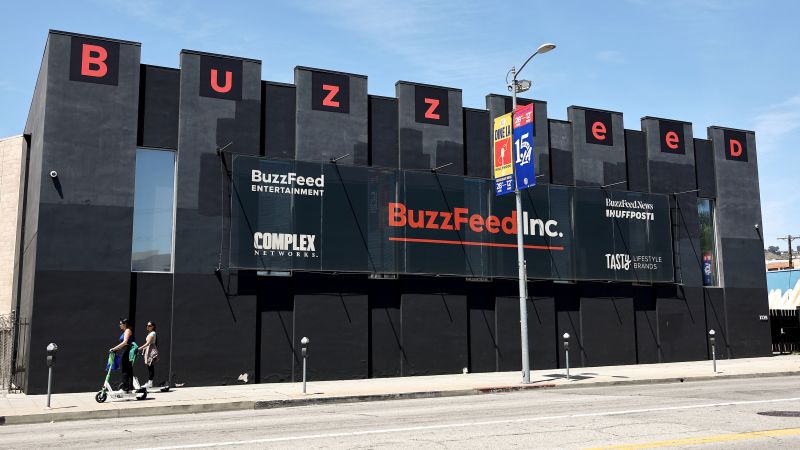Editor’s Note: A version of this article first appeared in the “Reliable Sources” newsletter. Sign up for the daily digest chronicling the evolving media landscape here.
Social media companies are soaking up the billions in advertising dollars that once flowed to legacy media companies — a trend that continues to accelerate despite an ever-growing mountain of evidence indicating the Silicon Valley titans govern their ballooning kingdoms with little regard for how their products negatively impact society.
While the dramatic shift has empowered these companies, it has also simultaneously dealt massive blows to news organizations, most of which are struggling to survive as they see their one-time revenue sources sour on their products in favor of tech platforms.
Just two months into 2024, several news organizations are already collapsing in plain sight. The Messenger shuttered last month; an already-slimmed down BuzzFeed announced it would slash 16% of its remaining staff; and Vice Media said it would lay off hundreds of employees and cease publishing on its website as it pivots to an entirely new business model. Over the last few years, the situation has grown more dire, with nearly every major news organization cutting their workforces to survive — if they can. Hundreds of local outlets have not been so lucky, closing their doors as advertising dollars disappear.
Not only are these news organizations crucial to the communities — both local and national — that they serve, but they also diligently work to ensure that their platforms are grounded in facts and free of abuse. You’re not going to find articles promoting body dysmorphia in the pages of The New York Times. The Wall Street Journal is not going to casually elevate carelessly risky investment advice. CNN will not enrich itself through imagery exploiting children.
And if any of these companies engaged in such behavior, it would be a major scandal that would not only leave their reputations scarred but also chase away advertisers. As a result, these organizations invest heavily in content moderation, providing a stream of hand-curated content for their audiences and brands to advertise around.
But the technology platforms, for some reason, are judged by markedly different rules. It’s not fair to say the road is littered with examples pointing to bad behavior. It’s buried in them. Time and time again, companies like Instagram, YouTube, TikTok, Snapchat and others have been caught allowing harmful content to exist on their platforms. In many cases, such content has not only been permitted to exist, but turbocharged via powerful algorithms. Child exploitation? Check. Promoting eating disorders? Check. Batshit crazy conspiracy theories that radicalize audiences? Check.
But when the executives of those companies, the very humans who control the platforms, find out about such content and are questioned about it? Well, plenty of evidence has shown they’ve often run the playbook of releasing vague public statements while failing to address the root causes in a meaningful way.
Just take last week for example. The Journal and The Times published reports (see here and here) indicating that Meta willfully allowed child sexual exploitation to exist on Instagram. The reports were both disturbing and damning, outlining how the popular platform is abused by some parents willing to sell content to predators. “The content, often featuring young girls in bikinis and leotards, was sold to an audience that was overwhelmingly male and often overt about sexual interest in the children in comments on posts or when they communicated with the parents,” The Journal’s Jeff Horowitz and Katherine Blunt reported.
The duo noted that Meta said it is committed to child safety and monitors its platform for abuse. But they also reported: “A review by the Journal of some of the most popular parent-run modeling accounts on Instagram and Facebook revealed obvious failures of enforcement. One parent-run account banned last year for child exploitation had returned to the platforms, received official Meta verification and gained hundreds of thousands of followers. Other parent-run accounts previously banned on Instagram for exploitative behavior continued selling child-modeling content via Facebook.”
Of course, this doesn’t represent the vast majority of the content on Meta’s platforms. But could you imagine if a legacy news organization trafficked in such behavior, even on rare occasion? The company would immediately be abandoned by advertisers and publicly excoriated, with executives having to issue apologies and beg for forgiveness. But when it’s Big Tech? Outside some brief boycotts that have sprouted up over the years and the occasional Capitol Hill committee hearing in which lawmakers (most of whom don’t understand the basics of these platforms) implore them to do more, the world largely turns a blind eye and endlessly scroll.
In effect, a substantial portion of the advertising dollars that once supported the carefully manicured gardens of legacy media outlets have migrated over to a free-for-all hellscape ruled by mostly unregulated Silicon Valley deities who prioritize profits and growth over the public good. As a result, the news organizations which work tirelessly to behave responsibly are seeing their business models collapse and future jeopardized, while executives like Mark Zuckerberg tout record profits.
To be fair, brands would likely prefer to advertise on the platforms of responsible media actors versus the risky world of social media. But Big Tech offers these brands much more effective targeting, while boasting a larger and younger audience than legacy news organizations. To make matters worse, news companies have been far too slow to adapt to the changing technological landscape, often sporting ugly websites and apps (sorry, it’s true!) and lacking the tools necessary to hone in on specific audiences advertisers want to spend their dollars to reach.
It’s a cocktail for disaster — one that will have profound impacts on civilization in the years ahead. News organizations, crucial to a functioning society, are being hollowed out, if not outright dying. Meanwhile, technology giants, which have allowed for harmful content to gain a foothold in the digital public square, are thriving.
Read the full article here




